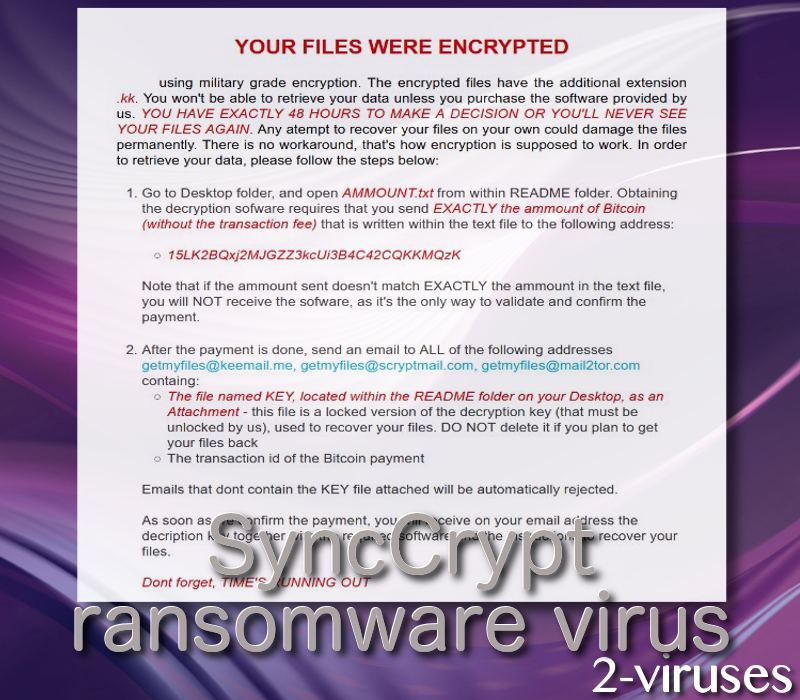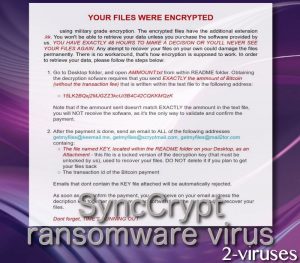SyncCrypt ransomware virus is extortionists’ tireless venture to threaten computer owners into silently handing over impressive sums of bitcoins. This threat has something in common with Locky crypto-virus: they both have been noticed to be transmitted in .wsf infectious files. In a neat readme.html and readme.png, people are introduced with most of the terms that have to be followed if the decryption key is to be released.
A military grade encryption, presumably an AES cipher (1), is the encoding tool that transforms files into pointless casualties. DNS request have also been noticed from Image.ibb.co (IP address 104.27.126.62) which leads experts to believe that crooks could be from United States. From this website, an image is downloaded that contains a .zip executable.
Alarming truth about SyncCrypt computer virus

This means that the infection could be assigned to the group of ransomware that exploit the same AES cryptography technique: like ABCLocker, OXAR, Explorer samples. Respectable security researchers have emphasized that there has been an increase in the amount of email-based attacks using harmful Windows Script Files (SWF) (2). This technique is also exploited by the creators of SyncCrypt crypto-virus. CourtOrder_845493809.wsf is regarded as the payload of this infection.
.kk extension will be appended to all ruined executables and victims will be recommended to contact all of the following email addresses: [email protected], [email protected], [email protected]. Only 2 days are given for people to make up a plan about the best solution to this infection.
According to the note, victims will find README folder, containing several files for distinct purposes. Before that, SyncCrypt malware will have to find a way to contaminate operating systems: as we have mentioned, it delivers rogue .wsf files. According to the completed scans (3), the payload is definitely malicious and is indicated as Trojan infection.
It is unknown whether individual fees are going to be applied to different victim, but the ransom is to be found in AMMOUNT.txt. When the ransom is sent, victims are insinuated to contact all three email accounts. If hackers are pleased with the sum received, they allegedly will unlock a KEY file from the README folder, containing the decryption code.
Information about decryption, removal and prevention of ransomware
To have your digital data (stored in hard drives or kept in constantly plugged USB flash drives) could easily become victims of an attack like SyncCrypt. To make sure that similar inconveniences never actually take place, we hope you will find it the time to back up your executables in appropriate services. Many utilities will adequately preserve your files. As long as you have a secure alternative for your data, ransomware samples are no threats.
Still, being compromised with a disturbing virus is no picnic: you will have to utilize an anti-malware tool, while only more skillful users will be able to obtain the same result manually. To ease this process, we think that running a scan with Spyhunter is more appropriate when it comes to getting rid of every trace of ransomware and Trojans.
If you wish to remain untouched by crypto-viruses, we can give you some recommendations that should direct you into the right location. First of all, do not download content from emails that you do not find 100% convincing. Attentively pre-check the authenticity of the sender before downloading an attachment or following a specific URL. Both of these tactics have been exploited to distribute ransomware infections.
Currently, there is no guaranteed way of having the salvation of restoring files free-of-charge. However, we do hope that this option will become available. That said, you should get familiar with other techniques of file-decryption. We are referring to the universal tools and Shadow Volume Copies that could function to some extent.
Synccrypt Virus quicklinks
- Alarming truth about SyncCrypt computer virus
- Information about decryption, removal and prevention of ransomware
- Automatic Malware removal tools
- How to recover SyncCrypt virus encrypted files and remove the virus
- Step 1. Restore system into last known good state using system restore
- 1. Reboot your computer to Safe Mode with Command Prompt:
- 2.Restore System files and settings.
- Step 4. Use Data Recovery programs to recover SyncCrypt virus encrypted files

Automatic Malware removal tools
(Win)
Note: Spyhunter trial provides detection of parasites and assists in their removal for free. limited trial available, Terms of use, Privacy Policy, Uninstall Instructions,
(Mac)
Note: Combo Cleaner trial provides detection of parasites and assists in their removal for free. limited trial available, Terms of use, Privacy Policy, Uninstall Instructions, Refund Policy ,
How to recover SyncCrypt virus encrypted files and remove the virus
Step 1. Restore system into last known good state using system restore
1. Reboot your computer to Safe Mode with Command Prompt:
for Windows 7 / Vista/ XP
- Start → Shutdown → Restart → OK.
- Press F8 key repeatedly until Advanced Boot Options window appears.
- Choose Safe Mode with Command Prompt.

for Windows 8 / 10
- Press Power at Windows login screen. Then press and hold Shift key and click Restart.

- Choose Troubleshoot → Advanced Options → Startup Settings and click Restart.
- When it loads, select Enable Safe Mode with Command Prompt from the list of Startup Settings.

2.Restore System files and settings.
- When Command Prompt mode loads, enter cd restore and press Enter.
- Then enter rstrui.exe and press Enter again.

- Click “Next” in the windows that appeared.

- Select one of the Restore Points that are available before SyncCrypt virus has infiltrated to your system and then click “Next”.

- To start System restore click “Yes”.

Step 2. Complete removal of SyncCrypt virus
After restoring your system, it is recommended to scan your computer with an anti-malware program, like Spyhunter and remove all malicious files related to SyncCrypt virus. You can check other tools here.Step 3. Restore SyncCrypt virus affected files using Shadow Volume Copies
If you do not use System Restore option on your operating system, there is a chance to use shadow copy snapshots. They store copies of your files that point of time when the system restore snapshot was created. Usually SyncCrypt virus tries to delete all possible Shadow Volume Copies, so this methods may not work on all computers. However, it may fail to do so. Shadow Volume Copies are only available with Windows XP Service Pack 2, Windows Vista, Windows 7, and Windows 8. There are two ways to retrieve your files via Shadow Volume Copy. You can do it using native Windows Previous Versions or via Shadow Explorer. a) Native Windows Previous Versions Right-click on an encrypted file and select Properties → Previous versions tab. Now you will see all available copies of that particular file and the time when it was stored in a Shadow Volume Copy. Choose the version of the file you want to retrieve and click Copy if you want to save it to some directory of your own, or Restore if you want to replace existing, encrypted file. If you want to see the content of file first, just click Open.
b) Shadow Explorer It is a program that can be found online for free. You can download either a full or a portable version of Shadow Explorer. Open the program. On the left top corner select the drive where the file you are looking for is a stored. You will see all folders on that drive. To retrieve a whole folder, right-click on it and select “Export”. Then choose where you want it to be stored.

Step 4. Use Data Recovery programs to recover SyncCrypt virus encrypted files
There are several data recovery programs that might recover encrypted files as well. This does not work in all cases but you can try this:- We suggest using another PC and connect the infected hard drive as slave. It is still possible to do this on infected PC though.
- Download a data recovery program.
- Install and scan for recently deleted files.

References:
- Advanced Encryption Standard. Tutorialspoint.com.
- Surge of email attacks using malicious WSF attachments. Symantec.com.
- Analysis. Virustotal.com.







